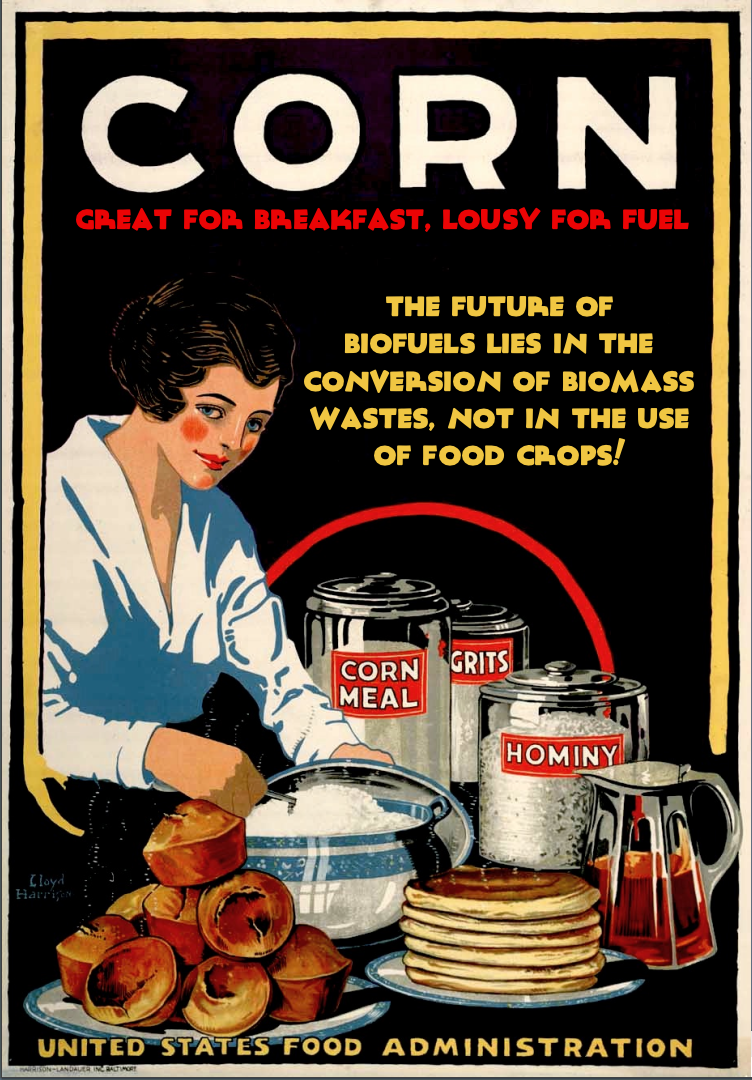ShopDreamUp AI ArtDreamUp
Deviation Actions
Description
Please disseminate widely, thank you! This does not give permission to alter or claim credit for this re-mixed work, for which I retain all copyrights. The original illustration is in the public domain.
If you disagree with the views expressed here, please be sure to read my Policy Statement BEFORE you post: [link]
This poaster has been prompted by several comments from other deviants indicating a great lack of knowledge about different sources of biofuels. Most people know about ethanol, or ethyl alcohol, which is derived from corn. It is simply moonshine made on an industrial scale. The sugar in corn is simply fermented and turned into alcohol. This process also works with sugar cane, sugar beets, and literally any other food crop (e.g., peaches or apples).
But, it's a waste of food, and there's not nearly enough corn to meet the Nation' demand for liquid fuels for transportation (gasoline and diesel).
The other common process used these day is called transesterfication, and involves the chemical transformation of the fats or fatty oils found in soybean, canola, palm seeds, and other plants, or waste fats from restaurants. This is how biodiesel is made. Again, this method, while it works, is expensive and wastes food supplies that could be better used in other ways. Moreover, as with the production of ethanol, there is not nearly enough supply to meet a significant portion of the demand for liquid fuels.
The newest technologies, still in the development stage, involve using a process called pyrolysis, wherein biomass (any formerly living material containing carbon, hydrogen, and oxygen) i converted into a bio-oil, or "green petroleum." The advantages of this method are several. First, there is a large supply of biomass waste available from agriculture, forestry, municipal garbage, and other source. About 1.3 billion ton of biomass wastes are available in the United States every year -- enough to replace about 25% of all gasoline and diesel consumption. Second, the supply is cheap -- cow manure for example is much cheaper than corn or soybeans. Third, this process turns environmental liabilities into environmental assets. Fourth, "green" fuels produced in this manner substantially reduce greenhouse gas and other pollutants, compared to both bio-fuels produced from corn or soybeans, and conventional liquid fuels produced from petroleum.
You can read more about the availability of waste biomass here: [link]
If you want to know more, I will soon post here a list of sources, written in plain English, that will help you improve your knowledge and understanding.
If you disagree with the views expressed here, please be sure to read my Policy Statement BEFORE you post: [link]
This poaster has been prompted by several comments from other deviants indicating a great lack of knowledge about different sources of biofuels. Most people know about ethanol, or ethyl alcohol, which is derived from corn. It is simply moonshine made on an industrial scale. The sugar in corn is simply fermented and turned into alcohol. This process also works with sugar cane, sugar beets, and literally any other food crop (e.g., peaches or apples).
But, it's a waste of food, and there's not nearly enough corn to meet the Nation' demand for liquid fuels for transportation (gasoline and diesel).
The other common process used these day is called transesterfication, and involves the chemical transformation of the fats or fatty oils found in soybean, canola, palm seeds, and other plants, or waste fats from restaurants. This is how biodiesel is made. Again, this method, while it works, is expensive and wastes food supplies that could be better used in other ways. Moreover, as with the production of ethanol, there is not nearly enough supply to meet a significant portion of the demand for liquid fuels.
The newest technologies, still in the development stage, involve using a process called pyrolysis, wherein biomass (any formerly living material containing carbon, hydrogen, and oxygen) i converted into a bio-oil, or "green petroleum." The advantages of this method are several. First, there is a large supply of biomass waste available from agriculture, forestry, municipal garbage, and other source. About 1.3 billion ton of biomass wastes are available in the United States every year -- enough to replace about 25% of all gasoline and diesel consumption. Second, the supply is cheap -- cow manure for example is much cheaper than corn or soybeans. Third, this process turns environmental liabilities into environmental assets. Fourth, "green" fuels produced in this manner substantially reduce greenhouse gas and other pollutants, compared to both bio-fuels produced from corn or soybeans, and conventional liquid fuels produced from petroleum.
You can read more about the availability of waste biomass here: [link]
If you want to know more, I will soon post here a list of sources, written in plain English, that will help you improve your knowledge and understanding.
Image size
752x1080px 921.22 KB
© 2012 - 2024 poasterchild
Comments44
Join the community to add your comment. Already a deviant? Log In
Why use corn at all, here in Wexford we have a small biomass plant that produces biofuel, it also uses rapeseed which provides oil for biodiesel and the remainder is converted into cheap cowcake, the farmers co-op who owns it also has members who have started growing African elephant grass which can be converted into more biofuel or into eco firelogs which are all sold locally. There's a couple of viable alternatives which also provide a way of supporting local level industry and jobs creation. brill poster






























